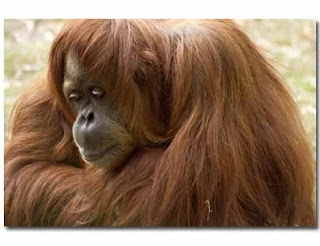Must-know Facts!
Let's know our closest relatives more! Here are some quick facts about our great apes a.k.a orangutans :
- Class: Mammalia
- Order: Primates
- Family: Hominodea
- Genus: Pongo
- Species: abelii (Sumatran) and pygmaeus (Bornean)
- Height: males about 1.2m; females about 0.9m
- Weight: males - 50 to 90kg; females - 30 to 50kg
- Life Span: Up to 60 years
- Gestation: about 8.5 months
- Number of Young at Birth: 1 (occasionally 2)
- Size at Birth: 3.3 to 4.5 pounds
- Age of Maturity: males - about 15 years; females about 12 years
- Status: Sumatran - Critically Endangered; Bornean - Endangered
- Orangutan means 'Person of the forest'; derived from the Malayan of Orang (person) and utan (forest)
- Orangutans arm span is longer than their height, which is ideal their tree dwelling lifestyles
- Orangutans have feet that have an opposable thumb , which makes them just as dextrous as their hands
- There you go. Now we know some facts about these great apes.
- credits to: red-ape.co.uk

The Pongo Abelli
 |
| The Pongo Abelii |
Commonly known as the Sumatran Orangutan, these primates are facing extinction due to humanity's action against them.
Let's read about these amazing animals.....
The Sumatran Orangutan (Pongo abelii) is one of the two species of orangutans. Found only on the island of Sumatra, in Indonesia, it is rarer and smaller than the Bornean Orangutan. The Sumatran Orangutan grows to about 1.4 metres tall and 90 kilograms in males. Females are smaller, averaging 90 centimetres and 45 kilograms.
Compared to the Bornean Orangutan, the Sumatran Orangutan tends to be more inclined to fruits and insects. Preferred fruits include figs and jackfruits. It also will eat bird eggs and small verterbrates. The Sumatran Orangutans spend far less time feeding on the inner bark of trees.
 |
| In this illustration, an orangutan is using a stick, to get the neesia seeds |
The Sumatran orangutan is only found in Sumatra island and is particularly restricted in the north of the island. In the wild, Sumatran orangutans survive in the province of Nanggroe Aceh Darussalam(NAD), the northernmost tip of Sumatra. The primate was once more widespread, as they were found more to the south in the 1800s such as in Jambi and Padang. There are small populations in the North Sumatra province along the border with NAD, particularly in the Lake Toba forests. A survey in the Lake Toba found only two inhabited areas, Bukit Lawang (defined as the animal sanctuary) and Gunung Leuser National Park In 2002, the Woeld Consevation Union put the species on the IUCN Red List with critically endangered status. The species is considered one of "The World's 25 Most Endangered Primates".
A survey in 2004 estimated that around 7,300 sumatran orangutans still live in the wild. Some of them are being protected in five areas in Gunung Leuser National Park; others live in unprotected areas: northwest and northeast Aceh block, West Batang Toru river, East Sarulla and Sidiangkat. A successful breeding program has been established in Bukit Tiga Puluh National Park in Jambi and Riau provinces.
Adapted from Wikipidea, The Free Encyclopedia
* Pictures do not belong to us.


Why is the Orangutans Endangered?
The orangutan depends on the forest to survive. Tragically, these great apes are seriously threatened because their habitat, the tropical forests of Borneo and Sumatra, is being lost at an alarming rate.
At one time the world’s wild orangutan populations likely included upward of hundreds of thousands of individuals, but current estimates indicate far fewer wild orangutans now remain. During the past decade orangutan populations have probably decreased by 50% in the wild. Although past climate shifts may have been responsible for some of this decline, orangutans are primarily threatened by human activities and development that cause the loss and degradation of their forest habitats. Currently, the IUNC has classified the Bornean orangutan as endangered and the Sumatran orangutan as critically endangered
Both species are in severe decline. This means that without drastic intervention, orangutans may soon be extinct as biologically viable populations in the wild.
So, having known that, what are you waiting for? Let's make a step in conserving orangutan now! As goes a saying, a journey of a thousand miles begins with a single step!
TQ

More facts about Orangutans!
Orangutan is one of the endangered species and some of them have been classified as critically endangered.There are two species of orang utan,the Sumatran orangutan (pongo abelii) and the Bornean orangutan (pongo pygmaues).
In the wild,orangutans may live up to 45 years or more and the oldest orangutan was a male who lived until the age of 58 at Philadelphia 200.Orangutan is the largest arboteal which means tree-living.Orangutans always travel through forest canopy and sleep in a new nest every night.They spend about 90 percent of their time in the trees of their tropical rain forest home.They make the nest using branches with leaves on them and the usually took 5 minutes to finish one nest.The babies will sleep with their mothers until they reach 8 years old.If it is raining enough,they will hold a large palm frond over their head as an umbrella.
Orangutans are a species of great ape along with gorillas,chimpanzees and bohobons,which have large brains.Unlike the other great apes,orangutan do not live in a large group.Adult males are usually found alone and adult females are usually accompanied by one or two offspring.
The males and females have visible differences.Adult males can reach 1.5m in height and weigh as much as 120kg.Females are much smaller with the height of 1m tall and weigh as much as 120kg.The one with large cheek pad and a throat pouch is the matures male orangutan and the orangutan use his throat pouch to make a loud sound called "long call" to alert the others to his presence and attract females.
Orangutans love to eat fruits,especially durian.Other than that,they also eat nectar,honey, bark,leaves,insects, and fungi.Orangutans are slow-growing animals and produce probably the lowest number of offspring over a lifetime of all mammals.A female becomes mature at the age of 10 and remains fertile until the age of 30 but others only start reproducing until they are about 15.Only 3 or 4 offspring are born during her lifetime.Excessive logging and wild capture for the pet trade impacts the species and leads to their extinction.
Males become sexually mature at the age of 12 and as they age, they will begin to develop the cheek flanges or pads and throat pouches that are so impressive by about the age of 20. However a young males growth of the cheek pads may be inhibited if there is a dominant male within his sensory range.
Orangutan mothers are very good at raising their babies to adulthood. The fact that the mother tends to keep her offspring with her for an average of eight years has everything to do with the low infant mortality rate. Offspring will become completely independent by the age 10. Infancy is from 0 to 4 years, juveniles from 4 to 7 years, adolescent males from 7 to 10 years and adolescent females 7 to 12 years old. Adolescent males usually break ties with their mothers, but adolescent females return frequently to spend time around their mothers.
Many baby orangutans are left orphaned when their mother orangutan is killed during the destruction of their jungle environment. A baby orangutan cannot look after itself effectively particularly when the orangutan has not been taught the vital skills it needs to survive. Unfortunately, deforestation and other human activities such as hunting, have placed the orangutan in danger of extinction.And estimated 5000 orangutans are killed every year due to the destruction of the rainforest to make way for the ever increasing palm oil plantation.


what is the Pongo pygmaeus?
 |
| pongo abelii-the most critical extinction |
Do you know?
it is an endangered species which is at risk of becoming extinct due to the change of environmental
or man's activities....
THE ORANGUTANS are the only exclusively Asian living genus of great ape. They are among the most intelligent primates and use a variety of sophisticated tools, also making sleeping nests each night from branches and foliage. They are generally not aggressive and live a mostly solitary life foraging for food. They are the largest living arboreal animals with longer arms than other great apes. Their hair is typically reddish-brown, instead of the brown or black hair typical of other great apes.
Native to Indonesia and Malaysia, orangutans are currently found only in rainforests on the islands of Borneo and Sumatra, though fossils have been found in Java, the Thai-Malay Peninsula, Vietnam and China. There are only two surviving species, both of which are endangered: the Bornean Orangutan (Pongo pygmaeus) and the critically endangered Sumatran Orangutan (Pongo abelii). The subfamily Ponginae also includes the extinct genera Gigantopithecus and Sivapithecus. The word "orangutan" comes from the Malay words "orang" (man) and "(h)utan" (forest); hence, "man of the forest".







